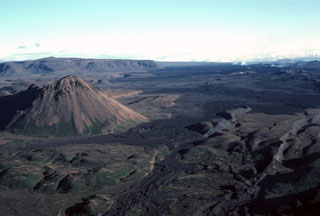Report on Krafla (Iceland) — November 1980
Scientific Event Alert Network Bulletin, vol. 5, no. 11 (November 1980)
Managing Editor: David Squires.
Krafla (Iceland) Eruption expected soon
Please cite this report as:
Global Volcanism Program, 1980. Report on Krafla (Iceland) (Squires, D., ed.). Scientific Event Alert Network Bulletin, 5:11. Smithsonian Institution. https://doi.org/10.5479/si.GVP.SEAN198011-373080
Krafla
Iceland
65.715°N, 16.728°W; summit elev. 800 m
All times are local (unless otherwise noted)
"After the October eruption the magma reservoirs at Krafla inflated rapidly until the last week of November. Ground-level monitoring indicates that at that time land over the magma reservoirs was higher than before the October eruption. During the week or so prior to 3 December, the rate of inflation has been slower and more irregular.
"From the pattern of behaviour so far, an eruption can be expected to take place soon. Evacuation plans and civil defense measures have been strengthened in case of an eruption in the S part of the fissure system, closer to the village near Lake Mývatn."
Geological Summary. The Krafla volcanic system in the Northern Volcanic Zone (NVZ) of Iceland is about 100 km long, consisting of a fissure swarm and a central volcano with a 7 x 9 km caldera formed about 110,000 years ago that deposited a rhyolitic welded tuff. It has been moderately active in the Holocene, over three distinct eruptive periods; the current one has lasted about 2,800 years with six volcano-tectonic episodes, each with one or more basaltic fissure eruptions. Lava volumes (DRE) have been in the 0.1-1 km3 range. The Hverfjall and Ludent tuff rings east of Myvatn were erupted along the fissure system. Myvatn lake formed during the eruption of the older Laxarhraun lava flow from the Ketildyngja shield volcano of the Fremrinamur volcanic system about 3,800 years before present (BP); The present Myvatn lake is constrained by the roughly 2,000 years BP younger Laxarhraun lava flow from the Krafla volcanic system. The abundant pseudocraters that form a prominent part of the Myvatn landscape were created when the younger Laxarhraun lava flow entered the lake. The last eruption took place in 1975-1984 CE when nine small basaltic fissure eruptions produced 0.25 km3 of lava.
Information Contacts: K. Grönvold, NVI.

